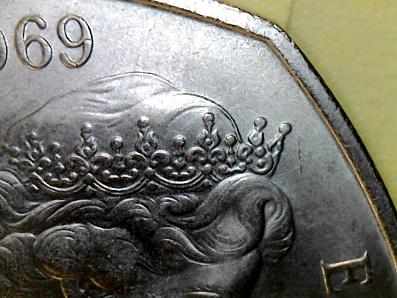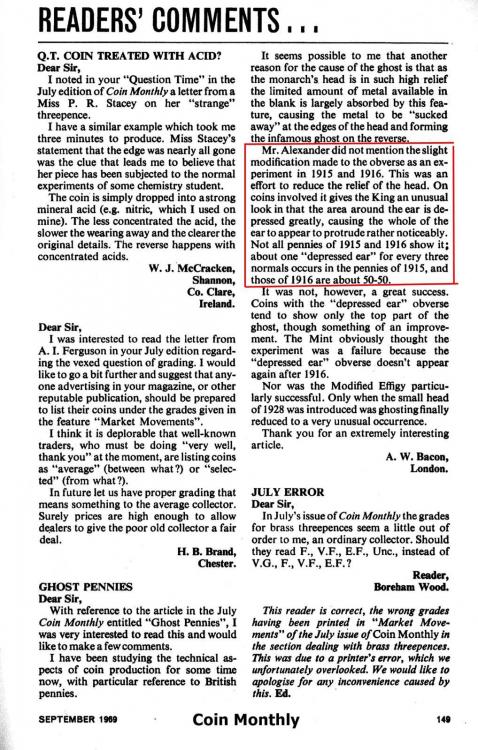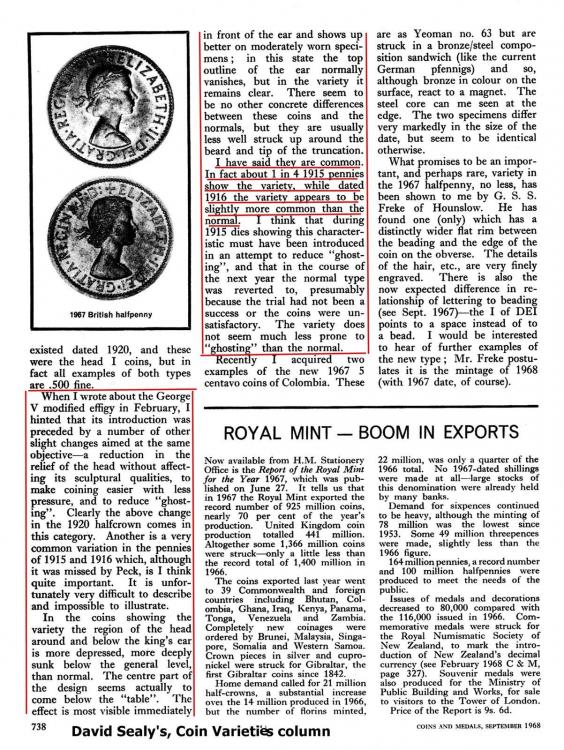
AardHawk
Newmismatist-
Posts
255 -
Joined
-
Last visited
-
Days Won
3
Content Type
Profiles
Forums
Events
Downloads
Store
Gallery
Articles
Everything posted by AardHawk
-
Summer in Queensland
AardHawk replied to ozjohn's topic in Nothing whatsoever to do with coins area!
I think they are suggesting it comes from the warm house (or perhaps from daytime solar heated water.) -
Summer in Queensland
AardHawk replied to ozjohn's topic in Nothing whatsoever to do with coins area!
You will be pleased to hear that nighttime PV panels (Anti-solar cells) are on the way https://www.sciencedaily.com/releases/2020/01/200129174512.htm -
Change your gender. I cant see the state pensions people objecting now that the lady who said that there were only two biological types of human was found guilty.
-
I'm not sure that you understand how ebay (the company) operates. They are not responsible for what is sold on their platform. They make their money by providing a platform for others to use and charging them for its use. Its the others who are responsible for the crap. People need to be more selective of whom they buy from, so maybe only buy from those who operate an ebay store and who presumably pay a fee to do so. I assume one can search only ebay stores. For those who are sell, open an ebay store and show that you are a step above the no fee dross. Just a few thoughts.
-
Coin Monthly Magazine
AardHawk replied to DaveG38's topic in British Coin Related Discussions & Enquiries
I have digitised all the Decimal content for my own use only. Theres not that much actually. I did photocopy all the predecimal variety stuff when I was into that, twenty years ago or so, and there is only a couple of hundred pages. -
Coin Monthly Magazine
AardHawk replied to DaveG38's topic in British Coin Related Discussions & Enquiries
They failed because sales fell as they raised the cover price. £4 or so then must be £10 today. I know I stopped buying it a couple of years previously because of the price. Content was crap as well. -
Coin Monthly Magazine
AardHawk replied to DaveG38's topic in British Coin Related Discussions & Enquiries
According to the Editorial in the May 1968 edition, they moved on the 1st of April. -
What?? I don't believe it!!
AardHawk replied to Peckris 2's topic in Nothing whatsoever to do with coins area!
Radio 4 Long Wave. I'm not trying to get at you Rob but one reads posts on a forum and assumes because of the authoritative answers on other subjects, that the people concerned are quite aged, but nine times out of ten, its not true. Anyway take a look at your old radio and you can probably select several wave bands, failing that it is available on Sky Radio on your telly, which is how I listen to the cricket these days. -
The earliest reference to this variety that I can find, was reported by David Sealy in his Coins Varieties colume in Coins and Medals in February 1969. With regard to the estimated totals, V,R,Court in his series, Major Varieties of U.K. Pennies 1902-1967, in the August 1972 issue of Coin Monthly, estimates c.55,500 examples were produced. He looked at 3,403 example of 1908 penny and found 6 examples. He does caution that the "small levels of incidence provide very unreliable bases for calculating accurate mintages. However, they probably indicate that only one die of each of these particular varieties was in use."
-
What is the Actual Mintage of the 1983 Two "NEW PENCE"?
AardHawk replied to VickySilver's topic in Decimal Coins
https://www.ebay.co.uk/itm/RARE-1983-2-New-Pence-in-Unrecorded-Royal-Mint-Brilliant-Uncirculated-Coin-Set/233308601941?hash=item365246be55:g:SdIAAOSwYXVc1C4A Been for sale for a month or two. -
They have been there in various guises for many years. The real mystery is why dont they publish the figures between 1977 and 2000.
-
I put a request for some info on the 5th Feb and previously a couple of month before, but have never received a reply. I think you get asked when you make a request for information whether you want to make it an FOI request. I decided against as I thought it was inappropriate. Next time I wont mess about.
-
No, not a compatibility problem. You used to be able to add 499kb picture, then save the topic. Then edit the topic and it would let you insert another 499kb picture. Repeat the loop etc til done, but it doesnt seem to let me do that any more. Never mind.
-
1973 89,775,000 X + EEC 356,616 Proof . X + EEC Single coin in case Issued, period ending 31th march, for 1973 (79,414), 1974 (259,980), 1975 (12,791), 1976 (2,711), 1977 (1.719). **100,000 Proof set. X + EEC Issued 1976 1974 **100,000 Proof set. 4 + A Issued 1976, scarcer i.a. --//-- 4 + B Trying to add multiple images. No go. Even saving then reediting doesnt seem to work any longer. Another failure.
-
Okay, so we've narrowed the problem down, it's the Yanks!! Dumb is another one. If you mean someone is stupid , why call them mute. As for the dates, I always told them the system will be using ISO format dates. That always stumps them. Huh, whats ISO? CCYYMMDD, get with the program dumb ass (strikethrough) you silly billy.
-
Royal Mint annual reports
AardHawk replied to AardHawk's topic in British Coin Related Discussions & Enquiries
I've arranged to visit the National Archives at Kew to view twelve annual reports, numbers 103 for the period 1972-04-01 - 1973-03-31 through to number 114 for the period 1983-04-01 - 1984-03-31, this coming Thursday. I am allowed to take a camera to photograph pages. I'm not sure what I'm going to discover. My main purpose is to determine actual production numbers of coins produced and in particular those for proof and BU sets, and VickySilver, will also be looking for coins produced for overseas governments. I chose those numbers for my initial visit because they overlap with data published in Coin Monthly and Coins and Medals in the early seventies, thought I fear they may not be definitive. I have a feeling that there are other reports from the mint giving more detailed information as both magazines published other mid term figures that were more specific. I find that the National Archives web site is not the easiest to navigate, and zero in on what you are looking for. I will report back. -
Royal Mint annual reports
AardHawk replied to AardHawk's topic in British Coin Related Discussions & Enquiries
Not yet, but I might be forced to. They annoyingly have them on their site for 2003 onwards and for bullion from 1968. I do know that 1978-9 thru 1997-8 reports are available for viewing at the Public Record Office(?) at Key for some large sum. I just cant believe that someone hasnt scanned them and got them online somewhere or hopefully written the figures down. I know that Chris was asking for figures some time ago, but I dont know whether he got them. -
I'm trying to track down reports for the late 70's thru to the 90's. The reports were published by HM Stationary Office until 1977 (report 107), since then, they seem to have been hidden until the early noughties when they started appearing on the lamentable Royal Mint web site. I'm looking for actual production figures of Proof and Mint sets and not the maximum allowable figures. I am not hopeful that the reports will actually help as the post 2000 reports are a complete load of tripe. They hardly mention coin production, mainly concentrating on employee diversity targets and other such carp. Anyone got any ideas or figures (including the source).
-
What's Your Job in Real Life?
AardHawk replied to Madness's topic in Nothing whatsoever to do with coins area!
IBM mainframe applications programmer. Retired & Grumpy. -
where to cash in new pence 2p coins from 1971-1983
AardHawk replied to dorey's topic in Decimal Coins
Here is an email (sent 06/04/2018) I received from the Royal Mint Museum; "Dear Mr AardHawk Please accept my apologies for the delay in response to your most recent email. Having reviewed the Annual Reports for the period in question, there were approximately 6,164,050 ‘Britain’s First Decimal Coins’ sets released by banks and post offices, with the coins for the sets being struck between 1968 and 1970. The reports we have seem to suggest that the 5p and 10p pieces included in these sets were only dated 1968 as this is the year that the coins were introduced into circulation as legal tender. However, there were 888,000 sets issued in 1969 and we can confirm that some of these did contain 5p and 10p pieces dated 1969. Unfortunately, we are not be able to say how many sets as the Annual Reports we have do not separate out the numbers for the sets. Kind regards Fiona Fiona Trumper Public Engagement & Information Officer" My own research shows that there are at least two different minor varieties of 2p, Reverses Aa and Ab. -
Peck, I would imagine it is so. Zkz, It would be nice to see a scan of your coin. Does it have the NE-SW fine parallel lines?
-
I came across this in David Sealy's Coin Varieties column in the December 1969 issue of Coins and Medals. It is probably the original report of this "variety". His explanation is as always, comprehensive.








